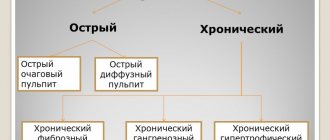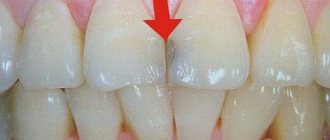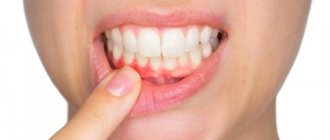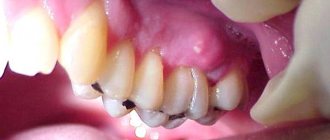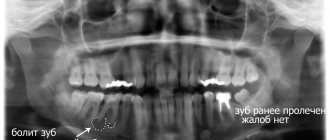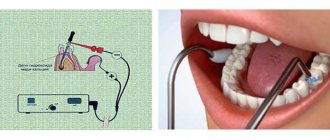If you suddenly have a severe toothache and the pain is throbbing, sharp, unbearable, then such symptoms may indicate tooth pulpitis. What kind of disease is pulpitis, why does it appear, how can it be cured and the tooth saved? We will answer all these questions in detail in this article. After reading the material, you will learn how tooth pulpitis occurs, what methods of its treatment are used in modern dentistry, and whether it is possible to cure tooth pulpitis at home or not.
Symptoms of acute pulpitis
As the disease develops, aching pain in the tooth first appears, which has an increasing character. The pain syndrome is constant or intermittent, significantly intensifies at night and with temperature influences. A diseased tooth reacts most strongly to cold. If you knock on the surface, the patient does not have any unpleasant sensations or they are insignificant.
The manifestations of symptoms of acute pulpitis depend on its form.
Hyperemia
It develops as a result of the activity of pathogenic bacteria that enter the dental tissue during untreated caries. It can occur during tooth preparation or after it has been treated with chemicals.
With hyperemia, the patient is concerned about the following symptoms:
- It's a dull pain. Occurs as a reaction to stimuli. Mostly, the painful attack does not last long, about 2 – 3 minutes, and at night lingering pain develops. In the case of an advanced form, the pain is felt as sharp and strong lumbago.
- Severe pain reaction when enamel is exposed to cold.
Acute focal
Signs that indicate the development of this form of pulpitis:
- Painful attacks occur spontaneously.
- They last for at least 30 minutes; in advanced stages they can last up to two hours.
- A carious cavity is revealed, which is painful during examination.
In acute focal pulpitis, the pain does not radiate to adjacent teeth.
Acute diffuse
It develops as a consequence of an advanced focal form and the lack of timely treatment.
Characterized by the following symptoms:
- The pain syndrome occurs spontaneously and suddenly, without exposure to any irritants. The pain is prolonged, does not go away for many hours, and radiates to nearby teeth.
- The presence of a carious cavity, when examined, a sharp painful reaction occurs. Remnants of filling material may remain.
Acute purulent
If the acute diffuse form is not treated, it gradually turns into a purulent form. Characteristic symptoms:
- The pain attack is cutting, acute in nature. The pain is constant and may periodically weaken or intensify.
- The pain radiates to neighboring teeth, as well as along the branches of the trigeminal nerve.
- When exposed to heat, the pain becomes stronger; when applying a cold compress, it subsides a little.
- Pus accumulates in the tooth cavity and can be detected by microscopic examination.
- The soft tissues melt and abscesses with pus form in them.
- The blood vessels are dilated and have many microdamages.
Traumatic acute
Develops as a result of tooth injury due to improper preparation of a carious cavity, chipping of a dental crown or fracture.
This form of pulpitis is characterized by the following symptoms:
- The pulp horn bleeds, which is noticeable during a dental examination.
- The dental cavity communicates pointwise with the carious cavity.
- In the pulp tissues, a bundle of vessels and nerves is exposed.
If there are signs indicating acute pulpitis of the tooth, treatment should not be delayed. A timely visit to the clinic will help save the tooth.
general information
Photo: pulpitis in aggravated form
There are many “home” folk treatment methods that allow you to avoid a trip to the dentist or, at least, delay it quite a lot. Traditional methods make it possible to stop the spread of inflammation and prevent infection from spreading to other areas, which is very important for preventing many inflammations of pulpitis.
All self-treatment methods help reduce inflammation and provide antimicrobial therapy, help get rid of swelling and pain
. The basis of all methods is natural remedies - some fruits, vegetables, as well as medicinal herbs.
You can also use available medications sold at pharmacies to provide first aid. After all, sometimes the first thing you need to do is relieve severe pain.
As effective methods of exposure, home treatment includes the following procedures:
- mouth rinses;
- irrigation;
- rubbing the medicine into the gum mucosa in the area where inflammation is localized;
- lotions and compresses;
- tampons;
- baths.
It is also worth mentioning that all folk remedies that are made from plants can have a completely individual effect and are perceived differently by the body.
That is why a remedy that is effective in one case may be practically useless in another. They should be used with caution, taking into account the characteristics of each patient’s body.
Causes
The reasons for the development of pathology may be the following:
- Tooth injury, mechanical or chemical. Violation of the integrity of enamel and dentin makes the pulp extremely vulnerable to the effects of the external environment and pathogenic bacteria.
- Gum diseases. In this case, there is a high risk of infection entering through open periodontal pockets.
- Complications of caries. Uncured caries or its advanced form contribute to the entry of pathogenic microorganisms - streptococci - into the pulp through the dentin tubules.
- Incorrectly performed dental treatment - damage to dental tissue, opening of a tooth performed in violation of technique, burn of dental tissue by arsenic, etc.
- Incomplete removal of carious tissue during treatment. The infection persists in the dental cavity and continues to develop.
- Poor quality filling installation. It is dangerous because there is a gap between the tooth wall and the filling material. Through it, pathogenic microorganisms penetrate into the pulp.
What to do if tooth pain persists
According to Dr. Bobkova, patients may experience pain when chewing after root canal filling. However, there is nothing wrong with this phenomenon if the unpleasant sensations disappear after two or three days.
“If the pain has been bothering you for a week or more, then you should consult your doctor. There can be several causes of pain - a fracture of the instrument, perforation in the tooth wall, removal of material beyond the apex of the tooth, or an additional canal was missed during the treatment process. Therefore, you cannot endure the pain; it is better to immediately contact your doctor.”
Diagnostics
Diagnosis of pulpitis takes place in several stages. The first is an examination of the oral cavity by a dentist. The patient's complaints about acute pain, the presence of injury or a carious cavity are taken into account. All this points to pulpitis. But it is impossible to determine the acute and chronic forms of the disease by one visual examination.
To determine the stage and type of pathology, the patient is prescribed an examination:
- X-ray.
- EDI or electroodontodiagnosis. This method allows us to identify the reaction of the pulp to the influence of electric current.
- Rheodentography. It is carried out to assess the blood supply to the dental pulp.
- Thermal test.
To make an accurate diagnosis, differential diagnosis of acute pulpitis is important. This is important so as not to confuse it with other diseases that have similar manifestations.
Rinse
To relieve pain caused by inflammation of the pulp, rinsing with tinctures or decoctions of medicinal herbs is often used at home. This procedure has many advantages:
- relieves pain;
- reduces swelling and itching;
- eliminates pathogens;
- prevents the spread of the inflammatory process to healthy tissue.
For rinsing to be beneficial, it is necessary to repeat it after 2-3 hours and use water at a temperature comfortable for the oral cavity.
.
To prepare medicinal decoctions, dentists recommend using various plants: chamomile, dry sage, oak or willow bark, elderberry.
Sage
To prepare the decoction, you need to pour 5 tablespoons of dried sage with two glasses of hot water, bring to a boil over the fire and continue to simmer for 35-40 minutes. The liquid should sit for at least two hours, after which it should be strained, cooled and used to rinse the mouth every 2.5-3 hours.
A decoction of sage will help reduce fever, reduce pain and eliminate pathogenic microorganisms from the carious cavity.
willow bark
The peeled willow tree bark is thoroughly crushed using a grater or a sharp knife, after which two tablespoons of this substance are poured into a glass of boiling water and left for 40-50 minutes.
A well-strained product can be used to rinse the mouth to relieve pain, inflammation and swelling. Rinsing should be done less than three times a day, preferably after eating.
Bay leaf
The leaves of the bay tree must be thoroughly crushed, then pour a tablespoon of the resulting crumbs with a glass of boiling water and leave for about two hours.
The liquid filtered through gauze is used to rinse the painful area of the mouth three to five times a day. The resulting medicinal solution helps reduce swelling of the gums, reduce the number of bacteria and slow down the development of the inflammation process.
Knotweed and elderberry
To prepare a healing decoction, dried elderberry and knotweed flowers are crushed, then mixed in a small container, a full tablespoon of each herb, and poured with a liter of boiling water. The solution, steeped for one hour, is filtered and used to rinse teeth every 2-3 hours.
This medicinal composition has antiseptic, anti-inflammatory and analgesic effects.
Pomegranate peel
The peel of one or two pomegranate fruits must be cut, pour a liter of boiling water and simmer over low heat for 2 hours. After cooling, the liquid is filtered and used for rinsing every three hours.
This remedy helps prevent the progression of the disease and relieves the pain associated with it.
Propolis with calamus
The solution is prepared as follows:
- 3 tablespoons of dry propolis must be thoroughly crushed;
- the resulting mass should be poured with alcohol in an amount of 100 ml and left in a dark place for 3-4 days;
- Add calamus tincture to the strained alcohol infusion at a ratio of 1:2.
To rinse the mouth, you need to dilute a tablespoon of the prepared infusion with a glass of boiled or filtered water.
The effect of the product is to disinfect the cavity present in the molar and reduce inflammation of the gum tissue.
Soda
To prepare the solution, a teaspoon of soda is dissolved in a glass of boiling water. After the liquid reaches room temperature, rinse the oral cavity thoroughly, especially the area of inflammation. It is important to rinse at least three times a day, half an hour after meals.
A soda solution helps to disinfect the affected area of soft tissue, relieve inflammation and reduce pain.
Peroxide
Rinse the mouth with an aqueous solution of hydrogen peroxide three times a day. They will help eliminate infection from the carious cavity, reduce the number of pathogenic organisms in the mouth, thereby preventing the progression of the disease.
Treatment of acute pulpitis
Treatment goals:
- stop a pain attack;
- eliminate inflammation and stop the infectious process;
- restore the anatomical shape of the tooth.
When dealing with acute pain, the patient is prescribed painkillers to reduce pain until the dental appointment.
The disease is treated in two main ways - conservative or biological and surgical. In both, therapy is carried out with preliminary anesthesia. The injection is given approximately 30 minutes before the start of treatment. For anesthesia, a solution of lidocaine or trimecaine is most often used.
Conservative method of treating acute pulpitis
The main goal is pulp preservation. The doctor conducts step-by-step treatment:
- gives an injection for pain relief;
- removes necrotic dentin;
- opens the tooth cavity;
- treats with antimicrobial agents;
- lays down medicine;
- puts a filling.
Conservative therapy is carried out mainly in young patients. This method requires mandatory consideration of the presence of diseases of the oral mucosa, as well as the localization of caries.
During treatment, anti-inflammatory drugs are used - Calcidont, Dical. Preparations containing calcium hydroxide are necessary to stimulate dentin formation. Proteolytic enzymes are necessary for tissue regeneration and swelling removal. After placing the medicine, the dentist closes the tooth cavity for several days - from 3 to 5. Next, if there is no reaction of the pulp, a permanent filling is placed.
Operative or surgical method
The doctor carries out the following stages of treatment:
- Provides first aid for acute pain.
- Gives an injection for pain relief.
- Opens the dental cavity.
- Removes pulp.
- Treats the cavity with an antiseptic.
- Puts in medicine.
- Installs a seal.
This method is used to treat acute diffuse pulpitis. If acute focal pulpitis is diagnosed, treatment involves removing the ostial and coronal pulp, while preserving the root pulp.
Surgical treatment is carried out in one or two visits.
For surgical treatment in one visit, the order is as follows:
- The doctor administers anesthesia and removes necrotic tissue.
- Using instruments, the tooth is filled with a non-toxic material.
When undergoing surgical treatment in two rooms, the procedure has a different procedure:
- First, the dentist applies arsenic or a devitalizing paste containing arsenic to the affected area of the tooth. This is necessary to kill the inflamed nerve. The duration of installation of arsenic on a diseased tooth is 24 hours on a single-root tooth, up to 48 hours on a multi-root tooth. Some types of pastes can be left for a long time - up to 7 - 15 days.
- A tampon with an anesthetic is placed in the canal and a temporary filling is placed. The patient is sent home.
- At the second visit to the dentist, the doctor extracts the arsenic or paste, completely removes the pulp and fills the tooth cavity.
The surgical treatment process is always monitored by radiography.
Folk remedies
In addition to traditional remedies used to relieve pulpitis, traditional medicine will also help relieve pain. Here is a small list of the most effective of them:
- A couple of drops of clove oil, applied to a small piece of cotton wool and applied to the sore spot, will reduce the severity of pain after some time. You can also try applying dried cloves, only before applying it you need to chew it a little, otherwise the essential substance will not be released;
- Fresh or salted lard applied to the inflamed area relieves pain well;
- Gargling with decoctions of St. John's wort, sage, chamomile, cloves, and elderberry flowers is very useful. You can also use an infusion of wine vinegar and mint and raspberry leaves. However, the preparation time for such an infusion is three days, so there is no need to talk about emergency assistance when using it;
- Another version of the decoction is prepared from two tablespoons of chopped turnips, which is poured with a glass of boiling water and boiled for ten to fifteen minutes;
- Suitable for relieving pain and rinsing with water with a drop of tea tree oil, as well as a solution of salt and soda;
- Alternative medicine also suggests applying the following remedies to an inflamed tooth: ice, raw beets, a leaf or stem of wild garlic crushed to a pulp, leaves of coltsfoot or horse sorrel, plantain root, juice from angelica leaves, propolis, “Asterisk” balm. , iodine (you should be very careful with the last three remedies, as they can severely burn the soft tissue of the gums and cheeks);
- Acupressure in the area of the inflamed area is very effective in reducing pain, if it does not cause even more pain.
One of the most favorite means of relieving all types of pain in Russia is alcohol. However, most often they try to take it orally, which should not be done, since pulpitis and alcohol are bad traveling companions. The only correct use of alcohol-containing drinks for inflammation is applying a moistened cotton swab or rinsing, but even here it is important to remember a few simple rules:
- Do not use pure alcohol!
- Do not rinse your mouth with sugar-containing drinks; only pure ones will do: gin, vodka, whiskey, cognac.
- Do not swallow the drink after rinsing.
Of course, alcohol can relieve pain for a short time and disinfect the problem area, but it will not cure inflammation.
Despite the fact that all these methods relieve pain for a short time, pulpitis still cannot be cured with tablets, so you should not put off visiting a doctor. Even if you are very afraid to treat pulpitis, anesthesia will make this procedure completely painless and quick. The process of tooth depulpation is carried out as follows: the damaged area is drilled out, the doctor uses special tools to remove the inflamed pulp and cleans the tooth cavity. If it is not possible to completely clean out all the soft tissue, arsenic, or rather a paste containing this substance, is used to treat pulpitis. It mummifies and dissolves the remaining pieces of nerve and pulp. Then the tooth cavity is thoroughly cleaned, disinfected and sealed.
Complications in the treatment of acute pulpitis
In some cases, as a result of treatment of acute pulpitis, the patient develops complications. Severe pain or increased sensitivity occurs when:
- biting hard food, chewing rough food;
- pressing on the tooth;
- exposure to cold water.
In such cases, the doctor prescribes treatment of the tooth with an anesthetic solution or a course of physiotherapy in the form of obtaining fluctuating currents. In case of relapses, it is recommended to replace the medication that was placed in the dental cavity during treatment. If such procedures are not effective, the affected tooth may be removed.
If treatment of acute pulpitis is required, the price depends on a number of factors. The final cost is influenced by the quality of the consumables used, medications, types of material for filling, as well as the equipment used. Dental clinics have a standard price list that indicates how much each procedure costs.
Elimination of tissue damaged by caries
Most often, tooth pulpitis is a consequence of advanced deep caries, and therefore, when treating inflammation in the pulp, a mandatory procedure is the elimination of the enamel layer and dentin with carious lesions. Damaged tissue is removed with a special tool using a drill.
However, when treating pulpitis, intact tissue will be partially removed; this is necessary to gain access to the pulp chamber and canal stomata that need to be treated.
